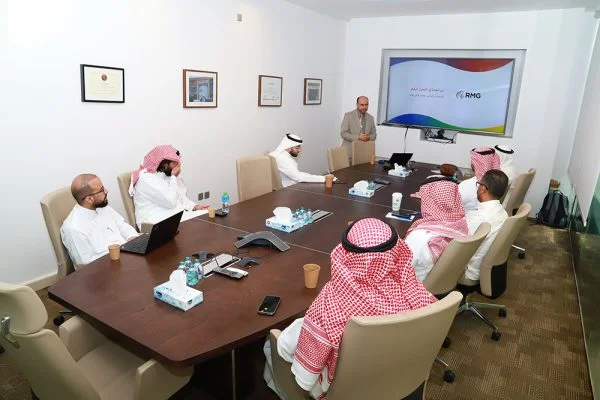Digital transformation
Building a digital transformation roadmap
The process of transforming towards digital business models is a very complex, multi-step process that requires comprehensive strategic planning that begins with building a strong Digital Transformation Roadmap to define the business transformation roadmap and the steps the company must take to achieve its transformation goals.
What is a digital transformation roadmap?
Business architecture represents a comprehensive view of: capabilities, values, services, procedures, policies, metrics, stakeholders, external stakeholders, and initiatives. The value of business architecture lies in providing an abstract representation of the organization and its current system in which it operates, as business architecture provides an effective communication and analytical framework that aims to:
- Translating digital transformation strategy into actionable initiatives.
- Enhancing the organization's ability to create real, valuable change, raising efficiency and performance by re-engineering or improving procedures, overcoming complexity, reducing risks, and making clearer decisions.
- Aligning business requirements through stakeholder engagement with other areas (applications, data, technology and cybersecurity).
- Leverage applications and technologies more effectively.


Therefore, business architecture should be positioned as a cornerstone of the digital transformation journey with a deeper focus on all activities that lead to the development of a digital business model.
Essentially, your digital transformation roadmap should address the following questions:
- What is the need for digital transformation in my business?
- How can I digitally transform my business?
- What resources do I need?
- What is the timeframe for achieving transformation?
- What digital transformation strategies do I need to survive in the future?

Need help/consultation?
Call us now; our entire team (+110 consultants and experts) will work to answer all your inquiries.
How to build a digital transformation roadmap?
The digital transformation roadmap is built, based on the business architecture concept, by going through four stages:
- Evaluating the external and internal situation
- Develop a digital transformation strategy and evaluate business impacts
- Business Solution Architecture
- Develop improvements, initiatives and develop solutions
Each of these stages consists of 6 main activities. Some may overlap but it is important to keep the stages in as sequential order as possible.

First: Analysis of external forces, influences and trends
In this stage, you analyze the current situation of your organization, and it includes carrying out the following activities:
Analysis of external forces, influences and trends
Identify the requirements of stakeholders and external beneficiaries and prioritize them
Analyze appropriate digital applications and technologies to enhance customer or beneficiary experience
Analyze the current business model and operating model
Analysis of the potential for change (change resistance)
Connecting at the relational level between the basic areas
Second: Developing a digital transformation strategy and evaluating business impacts
At this stage, you are working on creating a digital transformation strategy, which includes carrying out the following activities:
1- Identify different business scenarios
It enables the organization's senior management to review and evaluate service procedures by identifying risks and looking at new opportunities to improve them.
2- Classifying stakeholders and external beneficiaries and identifying technologies
In this step, we:
Classify stakeholders and external beneficiaries into categories,
Delve deeper into the analysis of business requirements,
Integrate the requirements of each category into Value Streams,
And match Value Streams with the best technical solutions to support these streams.
3- Developing the future business model
Understanding the various factors that characterize the current situation in the organization, business services procedures, and target segments using appropriate technologies that will support meeting the needs of external beneficiaries and stakeholders, forms the cornerstone on which the business model development must take place. After that, all elements of the business model begin to be developed, taking care to achieve compatibility between them.
4- Developing the structure of the strategy’s goals and objectives
Strategy is represented as sequential goals and objectives, by classifying goals, then linking each group of goals to objectives, and linking the actions that must be taken to achieve each strategic goal.
5- Business architecture impact analysis/objectives
Analyzing the business architecture impact of each strategic objective is easily done by following the relational linkage between the core domains (1.6 above).
6- Impact analysis of business architecture/IT architecture
Analysis of the impact of Business Architecture/IT Architecture provides sufficient understanding of the extent to which strategy and Business Architecture influence other areas (applications, data, technology and cybersecurity). It is important at this stage to capture all the observations on the areas so that they can later be taken into account when building the future situation.
Third: Business Solutions Architecture
The future business model is the primary goal on which all other core areas (applications, data, technology and cybersecurity) should be based.
Identify the capabilities (competencies), motivations, reward system and organizational work culture necessary to achieve the future business model (future business architecture).
Modifications, if necessary, (merge, add… etc.) for the parts/sectors of the organizational structure based on the requirements of the new future business model.
A value chain explains how an organization creates value and how it exchanges it with its stakeholders. Future value chains are modeled and analyzed to a more or less detailed process level as needed.
Clear definition of the architecture of other core areas (applications, data, technology and cybersecurity).
Analysis and assessment of the gaps between the current and future situation to reach a clear understanding and initial prediction of the size of the changes required to be implemented.
Fourth: Implementing improvements, initiatives, and developing solutions.
After completing the gap analysis between the current and future situation, requirements, steps, and all improvements are identified, initiatives are identified, and initiatives are linked to strategic goals.
The budget and remaining resources are determined for each initiative, with priorities determined based on the importance of the goal to be achieved through a particular initiative, the cost/benefit analysis, and the timeline for each initiative or project. The primary focus is usually on adopting emerging technologies, such as advanced software, blockchain, artificial intelligence (AI), robotic process automation (RPA) and others.
It is necessary to define measurement standards and define a performance indicator for each initiative to monitor work progress. Each performance indicator must be documented (what data will be used? How, when, and by whom will the data be collected? How will the data be analyzed? How will the KPIs be calculated, etc.). All these questions must have clear answers and practical methods that can be measured and compared.
Each initiative is translated into a concise project plan that precisely defines objectives, scope, stakeholders, external beneficiaries and timeline within an expanded work plan comprehensive for all initiatives.
Gaps between the expanded work plan and the executive plan are monitored and corrective actions are implemented if necessary to ensure that the executive plan matches the expanded work plan.
Continuous evaluation through performance indicators.

Our services help you build your digital transformation roadmap
At Renad Al Majd for Information Technology and Consultancy (RMG), we realize the critical importance of developing the digital transformation roadmap, and we provide a set of integrated services that help your organization during the digital transformation journey, including:
- Conduct gap analysis and digital maturity assessment
- Developing a digital transformation strategy and IT strategies
- Developing the executive plan for digital transformation
- Supervising the implementation of digital transformation projects and initiatives
- Providing training programs and workshops to raise the level and develop digital capabilities
- Establishing a digital transformation office
- Enabling enterprises to use emerging digital technologies, such as digital intelligence, big data, and others

Need help/consultation?
Contact us now! +105 consultants and technical experts will answer your inquiries within minutes.













